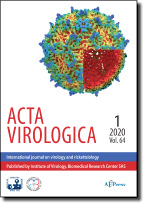Journal info
|
||
Select Journal
Journals
Bratislava Medical Journal Ekologia - Ecology Endocrine Regulations General Physiology and Biophysics Neoplasma Acta Virologica Current articles 2023 2022 2021 2020 2019 2018 2017 2016 2015 2014 2013 2012 2011 2010 2009 2008 2007 2006 2005 2004 2003 Studia Psychologica Cardiology Letters Psychológia a patopsych. dieťaťa Kovove Materialy-Metallic Materials Slovenská hudba 2025Webshop Cart
Your Cart is currently empty.
Info: Your browser does not accept cookies. To put products into your cart and purchase them you need to enable cookies.
Acta Virologica Vol.59, No.4, p.317-337, 2015 |
||
| Title: Bluetongue: Indian perspective | ||
| Author: K. RANJAN, P. MINAKSHI , G. PRASAD | ||
| Abstract: Bluetongue (BT) is an insect borne (Culicoides) viral disease of small ruminants in India. While seroprevalence for BT is observed mostly in domestic and wild ruminant animals, the clinical form of disease and severe mortality is observed in sheep. Since the first report of BT in 1960s the country became endemic for the disease and most of the BT virus (BTV) serotypes (22 out of 27 worldwide) have been reported. The genome sequence analyses of these viruses revealed that both the eastern and western topotypes as well as their reassortant strains are present in India. It further revealed that some of these viruses are very close to live vaccines used in other countries. The severe economic concern justifies the need to develop sensitive and reliable diagnostic tests for BT. The virus isolation followed by identification by electron microscopy is gold standard test, but it is time consuming and not easily available in all the laboratories. Therefore, nucleic acid-based rapid diagnostic tests such as PCR, real-time PCR etc. are used nowadays. The BT control program in India includes vector control as well as effective vaccination. The vector population is controlled by vector traps, synthetic pesticides and some of the herbal compounds. For effective vaccination, the serotypes prevalent in a particular geographical area must be known, which can be achieved by continuous monitoring and sero-surveillance of disease. The multivalent inactivated vaccines are more suitable for India in comparison to modified live vaccines as the latter may turn to virulent and may lead to severe outbreak of the disease. |
||
| Keywords: bluetongue virus; Culicoides; PCR; nucleic acid sequencing; India | ||
| Published online: 06-Dec-2015 | ||
| Year: 2015, Volume: 59, Issue: 4 | Page From: 317, Page To: 337 | |
| doi:10.4149/av_2015_04_317 |
||
|
|
 download file download file |
|

